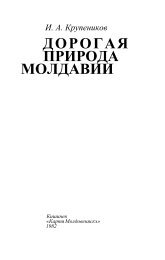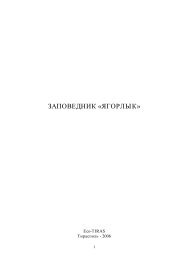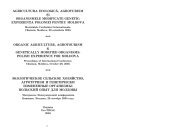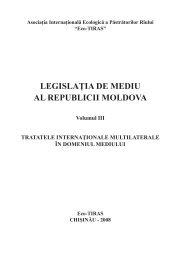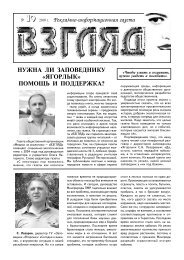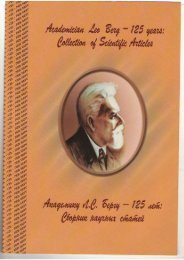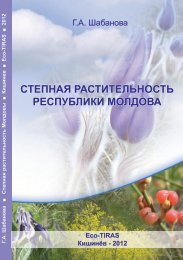исследований (табл.1), но в отдельных случаях могутбыть источниками поступления в водную толщу некоторыхэлементов (особенно марганца). Илы самогонижнего водоема р. Бык (Калфа) характеризуютсябольшим содержанием многих микроэлементов (9из 14 исследованных). Если говорить о загрязненииилов микроэлементами, то из данных (табл. 3) можноуверенно заключить, что донные отложения Молдовызагрязнены B, Mn, Ba, Cu, Ni и Sr; не загрязнены – Pb,Zn, Ti и Zr; возможно загрязнены (единичные образцыиз сотен) –Co, Cr, Mo и V.Выводы1. Общая минерализация и содержание микроэлементовв воде, почвах и донных отложениях возрастаютот истока к устью.2. Отмечено превышение ПДК по ряду микроэлементовв воде нижнего течения реки и в донных отложенияхбольшинства исследованных образцов.Литература1. Агропочвенное районирование Молдавской ССР/ под редакциейКрупеникова И.А. Изд-во «Картя Молдовеняскэ». Кишинев,1985-168 с.2. Н.В.Горячева, Г.Г.Дука Гидрохимия малых рек Республики Молдова.Кишинев. Изд.-полигр. центр Молд. гос.ун-та, 2004.– 288 с.3. Проблемы качества, использования и охраны водных ресурсовССР Молдова. Под редакцией Р.П. Кацер. Кишинев: Штиинца,1991. -286 с.4. Зубкова Е.И. Распределение и миграция микроэлементовв бассейне р. Днестр. Автореферат диссертации …канд. географ.наук. Ростов-на-Дону, 1986.-24 с.5. Тома И.С., Рабинович И.С., Великсар С.Г. Микроэлементы иурожай. Кишинев: Штиинца, 1980. -172 с.6. Бумбу Я.В., Цуркан П.А., Вартичан И.И., Надкерничный Н.П.О запасах микроэлементов в иловых отложениях водоемов МССР.Изв. АН МССР. Кишинев, 1978, с. 68-71.7. Зубкова Е.И., Бызгу С.Е. Микроэлементы в донных отложенияхКучурганского водохранилища.– В кн.: Современное состояниеэкосистем рек и водохранилищ бассейна Днестра. Кишинев:Штиинца, 1986, с. 22-31.8. Rusu V., Lupaşcu T. Chimia sedimentelor acvatice. Proprietăţide suprafaţă. Modele fizico-chimice.– Ch.: Elena V.I., 2004.– 272 p.М. Kolisnichenko, N.N. MakarovaSchool № 6, <strong>Tiras</strong>polPUPILS’ CONCERN OF WATER POLUTION IN TMRДанная статья затрагивает некоторые проблемы экологии бассейна реки Днестр на территории ПМР. Авторы также вносятнекоторые предложения об улучшении существующей ситуации.The urgent solving of ecological problems is thestaple task of modern society as well as of the populationof Transnistrian Moldavian Rpublic. This is the reason ofwriting this report.For centuries man lived in harmony with nature untilthe industrialization brought human society into conflictwith the natural environment. Today the contradictionsbetween man and nature have accured a dramaticcharacter. With the development of civilization man’sinterference in nature has increased. Every year theworlds industry pollutes the atmosphere with millions oftons of dust and other harmful substances.Deficiency of water resources, which are not enoughto cover the needs of the population, economy andnatural ecosystems, is one of the major environmentalproblems both for Transnistria and Moldova as a whole.The Dniester river with its tributaries and undergroundwaters is the basic water resource of Tansnistia.Chemical analysis show that the Dniester river watershould be assigned to class III in terms of pollution(moderately polluted) and small river and streamwaters to class IV (polluted) and V (very polluted). TheDniester water is primarily contaminated with biogenicsubstances( such as phosphates, nitrites, ammoniumnitrogen) and phenols, oil products, synthetic surfactants.Copper impurities levels remain steadily high. The levelof microbiological contamination is also quite high.The deficiency of water resources is explained by thephysicogeographical features of the region, such as apoorly developed hydrographic network, lie of the ground,climatic conditions, low annual precipitation.As the regional economy overcomes the crisis,contamination of the Dniester with industrial wastes willincrease.Below there are major factors responsible forwater resources contamination:Discharge of undertreated or untreated sewage dueto a lack or low efficient operation of sewage works.Lack of sewage works at many storm water systems.Improper control over the quality of effluentsdischarged by industrial enterprises into the sewer on theside of the public utilities authorities.Washout of agrochemicals, pesticides and othercontaminating substances from the fields, storage areas,animal farms, spontaneous refuse dumpsLack of any, or non– compliance with the regulationsof use of water protection and sanitary zones.Underground waters are the main source for potablewater supply(90-99 %) the quality of water in the centralwater supply systems is generally meets the requirementsof the GOST, except foe the ardness and iron loads.The hygienic characteristics of water in the Dniesterriver at places of water use (mass recreation zones)continue getting worse.According to the bacteriological laboratory of theRepublican Center of Hygiene and Epidemiology, thepercents of seeding of cholera –like NAG germs is this:July-August achieved 68.8% for samples taken from theDniester water and even 75-80 % for the samples takennear Bendery, <strong>Tiras</strong>pol and Slobodzeya region.In 2000, the TMR Government adopted a resolution onTop-priority Urgent Measures on Protection, and RationalUse of Underground waters to regulate the matters relatedto complex use and protection of underground waterresources used for household and industrial purpose.The pupils of our school are also worried about theproper state of the river Dniester. The pure and drinkablewater of our river which we can call our vital source has— 101 —
always been the public concern of both the population ofour republic and students of our school. So we suggestthat pupils of all the schools of <strong>Tiras</strong>pol should:1) make outings on the Dniester River in order tostudy flora and fauna of our region and2) clean surroundings of the river from rubbish left byirresponsible people.3) making fires on the Dniester banks must bebanned.Besides we suggest1) taking measures on planting a park on the eitherbank opposite the center of <strong>Tiras</strong>pol2) improving the sanitarian state of the city area whichshould result in cleaning waterstreams being dischargedinto the Dniester River.References1. Константинов Е.В. «Экологическая безопасность и проблемаутилизации отходов в Тирасполе»2. Кольцова А. «Другой планеты у нас не будет»РАСЧЕТНЫЕ МЕТОДЫ ПРОГНОЗА БИОЛОГИЧЕСКОЙ АКТИВНОСТИОРГАНИЧЕСКИХ СОЕДИНЕНИЙ НА ПРИМЕРЕ ПЕСТИЦИДОВО.Г. КолумбинПриднестровский государственный университет им. Т.Г. ШевченкоОдним из основных источников загрязнения почвыявляются пестициды и агрохимикаты. До 70 % складовдля хранения пестицидов в регионе не отвечаютсанитарным требованиям [3].В июле 2003 г. на территории Рыбницкого районапри выборе участка под полигон для ТБО была обнаруженасвалка брошенных в 70-х годах пестицидовхлорорганической группы [3]. В течение ряда лет решалсявопрос захоронения пестицидов и минеральныхудобрений, которые за десятилетия пришли в негодность,и представляют экологическую опасность врайонах республики. А это десятки тонн.Проблема загрязнения окружающей среды пестицидамиимеет несколько отличительных аспектов:1. Пестициды распространяются далеко за пределытех агросистем, в которых были внесены.2. Многие пестициды имеют высокую стабильностьв природных средах. Период полураспада ДДТв воде составляет 10 лет, диэлдрина – более 20 лет.3. Пестициды имеют широкий спектр токсическоговоздействия, влияя на все живые организмы.4. Многие пестициды метаболируют с образованиемболее токсичных и очень устойчивых в окружающейсреде веществ. ДДТ при участии микроорганизмовпревращается в дихлордифенилдихлорэтан (ДДД),а под действием солнечного света – в дихлордифенилдихлорэтилен(ДДЭ). Эти метаболиты не уступаютДДТ по токсичности и устойчивости [2].Современная технология ставит перед ученымизадачу разработки методов надежного предсказанияфизико-химических и биологических видов активностиразличных классов химических соединений. Этапроблема имеет общее название количественноесоотношение структура-активность (QuantitativeStructure – Activity Relationship, QSAR) и в настоящеевремя является многопрофильной задачей, включающейв себя различные подходы не только в рамкахразличных отраслей химии, но и физики и математики.QSAR позволяет изучение различных систем параметровмолекул и методов оценки биологическойактивности на основе статистического анализа эмпирическихданных. Нами этот метод используется дляисследования токсичности и липофильности некоторыхпестицидов.Для того, чтобы найти соотношение между заданнымвидом активности органических соединений и ихструктурой, последнюю необходимо представить вчисленном виде. Численные характеристики, выражающиеструктурные особенности молекулы, получилиобщее название дескрипторов молекулярной структуры(или просто дескрипторы). В связи с этимглавная проблема QSAR – выбор такого (желательноминимального) набора дескрипторов, который достаточендля описания заданного свойства. Хорошиеперспективы при решении данной проблемы имеютметоды квантовой химии, с помощью которых можнопроводить расчеты электронной структуры и геометриисамых разнообразных химических систем вплотьдо моделирования эффектов среды и взаимодействиямолекулы с рецептором.Особенностью проблематики QSAR является необходимостьширокого внедрения математическихметодов обработки экспериментальных данных, позволяющихстроить различные типы функциональныхзависимостей. Здесь наряду с хорошо известным регрессионныманализом применяются факторные методы,позволяющие выделять наиболее существенныепараметры, описывающие систему, а затем проводитьклассификацию химических соединений по типам биологическойактивности. В целом методология QSARпозволяет заменить поиск соотношений «структура– активность» анализом соотношений «дескрипторы– активность» и на конечном этапе исследований получатьмодельные функции вида:Y = Y (d 1, d 2, …, d N),где искомое свойство Y выражается через значениядескрипторов молекулярной структуры d i. Подобныеуравнения фактически являются схемами для расчетасамых различных свойств органических соединений[1].Область применения построенных моделей зависиткак от их качества с точки зрения статистики, так иот представительности базы данных, использованнойдля их построения.В процессе моделирования важно контролироватьпрогностическую способность построенных моделей.Один из наиболее надежных подходов к решениюэтой задачи состоит в разделении исходной базыданных на обучающую выборку, использующуюсядля построения моделей, и контрольную выборку.— 102 —
- Page 3 and 4:
Descrierea CIP a Camerei Nationale
- Page 5 and 6:
Уважаемые коллеги,
- Page 7 and 8:
щегосударственной
- Page 9 and 10:
доме, в котором мы в
- Page 11 and 12:
шие глубины на заде
- Page 13 and 14:
с малыми восстанов
- Page 15 and 16:
Литература1. Жадин
- Page 17 and 18:
Рис. 3. Многолетняя
- Page 19 and 20:
тера и глубины изме
- Page 21 and 22:
ПОДДЕРЖАНИЕ БИОРАЗ
- Page 23 and 24:
Таблица 5. Оптималь
- Page 25 and 26:
Таблица. Результат
- Page 27 and 28:
ФОРМИРОВАНИЕ БИОЦЕ
- Page 29 and 30:
Подавляющее больши
- Page 31 and 32:
Рис.1. Днестр вблизи
- Page 33 and 34:
сопоставимости дан
- Page 35 and 36:
ции с международны
- Page 37 and 38:
А.Н. Бургеля, К.П. Бу
- Page 39 and 40:
Выводы1. Уже на само
- Page 41 and 42:
тегории, виды и пор
- Page 43 and 44:
санитарно-эпидемио
- Page 45 and 46:
Таблица 4. Распреде
- Page 47 and 48:
реационных, монито
- Page 49 and 50:
Шабановой Г.А. и Кух
- Page 51 and 52: могут быть убраны,
- Page 53 and 54: Турунчук. Связь с с
- Page 55 and 56: Праздник «День Рек
- Page 57 and 58: 500ЈPРис. Распределе
- Page 59 and 60: Н. Гроссу * , Р. Шакир
- Page 61 and 62: Рис.1. Помесячное ра
- Page 63 and 64: Calitatea apei r. Nistru conform gr
- Page 65 and 66: Карта геохимическо
- Page 67 and 68: лесу был дуб, сегод
- Page 69 and 70: При предварительно
- Page 71 and 72: щих улучшить социа
- Page 73 and 74: ней опасных загряз
- Page 75 and 76: ФотоприложениеФот
- Page 77 and 78: в Украине - одесска
- Page 79 and 80: тия по гидрохимиче
- Page 81 and 82: ветствующих санита
- Page 83 and 84: ния полей, так и для
- Page 85 and 86: В. Экономический ан
- Page 87 and 88: Таким образом, плат
- Page 89 and 90: Рис. 2. Динамика нор
- Page 91 and 92: Табл. 1а. Статистиче
- Page 93 and 94: Выводы1. Наибольшее
- Page 95 and 96: Для днестровской в
- Page 97 and 98: ЭКОЭТИЧЕСКОЕ ВОСПИ
- Page 99 and 100: Таблица 1. Валовое с
- Page 101: почвенный покров п
- Page 105 and 106: и уникальными по си
- Page 107 and 108: ются основными фак
- Page 109 and 110: Рис. 4. Пораженность
- Page 111 and 112: ight to use”. Varone et al. (2002
- Page 113 and 114: mass media, etc., which belong to d
- Page 115 and 116: В связи с тем, что К
- Page 117 and 118: период поездки вых
- Page 119 and 120: doutchinae (d’Orb.), выше з
- Page 121 and 122: вместе с осадками в
- Page 123 and 124: Таблица 4. Содержан
- Page 125 and 126: efectuat în baza următorilor indi
- Page 127 and 128: видуальных различи
- Page 129 and 130: - соответствующее з
- Page 131 and 132: ФАУНА КЛЕЩЕЙ ДРЕВЕ
- Page 133 and 134: Таблица 1. Данные ра
- Page 135 and 136: РЕКРЕАЦИОННЫЕ РЕСУ
- Page 137 and 138: ЭТАПЫ ЭВОЛЮЦИИ БИО
- Page 139 and 140: Плотина Дубоссарск
- Page 141 and 142: чимые. При этом «пе
- Page 143 and 144: Схематически получ
- Page 145 and 146: Таблица 5. Данные на
- Page 147 and 148: Risks for biodiversity with tested
- Page 149 and 150: 14. Ярошенко M.Ф., Дед
- Page 151 and 152: 20082009Fig. 2. Structure of shrew
- Page 153 and 154:
с природой (различн
- Page 155 and 156:
делить в их предела
- Page 157 and 158:
Таблица. Оценка эне
- Page 159 and 160:
лах Приднестровья
- Page 161 and 162:
ВыводыКраеведческ
- Page 163 and 164:
вий среды жизнедея
- Page 165 and 166:
Senecio besserianus Minder. Cypripe
- Page 167 and 168:
Рис.1. Почвенная кар
- Page 169 and 170:
половины площади п
- Page 171 and 172:
Рис. 2. Современное
- Page 173 and 174:
ПРИЧИНЫ ГЕОМОРФОЛО
- Page 175 and 176:
RÂURILE MICI CU ŞANSE MARIDE A FI
- Page 177 and 178:
ЭКОНОМИКО-ЭКОЛОГИЧ
- Page 179 and 180:
прибрежной зоной (п
- Page 181 and 182:
Строительство в пр
- Page 183 and 184:
государственного у
- Page 185 and 186:
ческий, социальный
- Page 187 and 188:
ми, послужило весом
- Page 189 and 190:
губительно влияющи
- Page 191 and 192:
ных за контролем и
- Page 193 and 194:
PECULARITIES OF DYNAMICS OF PHOSPHO
- Page 195 and 196:
Fig. 4. Spatial and seasonal dynami
- Page 197 and 198:
• inventory of point discharges s
- Page 199 and 200:
СТЕРИЛИЗАЦИЯ КАК С
- Page 201 and 202:
гормоны (в незначит
- Page 203 and 204:
ПРОТОКОЛ ПО ПРОБЛЕ
- Page 205 and 206:
воды ежегодно умир
- Page 207 and 208:
РАЗРАБОТКА ПЛАНОВ
- Page 209 and 210:
ставляет материаль
- Page 211 and 212:
• Совершенствован
- Page 213 and 214:
«Алые паруса». Таки
- Page 215 and 216:
which the Committee is then require
- Page 217 and 218:
нием, культурой и х
- Page 219 and 220:
- Николаевская церк
- Page 221 and 222:
Сброшенный на 50 м б
- Page 223 and 224:
СТРУКТУРА ГЕОИНФОР
- Page 225 and 226:
4. Пространственная
- Page 227 and 228:
На фазе пика числен
- Page 229 and 230:
А.А. Тищенков, В.В. М
- Page 231 and 232:
Распределение видо
- Page 233 and 234:
цветковый (ККП, ЧКУ,
- Page 235 and 236:
очередной задачей
- Page 237 and 238:
схемой планировани
- Page 239 and 240:
эксплуатационным п
- Page 241 and 242:
ных дамб, с возвращ
- Page 243 and 244:
ледствия от урбани
- Page 245 and 246:
ОСНОВНЫЕ ФОРМЫ ДЕГ
- Page 247 and 248:
УЧАСТИЕ НЕПРАВИТЕЛ
- Page 249 and 250:
струкции как от сбр
- Page 251 and 252:
Рогоз широколистны
- Page 253 and 254:
Таблица 3. Изменени
- Page 255 and 256:
В рамках первых тре
- Page 257 and 258:
Основные экскурсио
- Page 259 and 260:
2. Кравченко Е.Н. При
- Page 261 and 262:
Decision-Maker user group are respo
- Page 263 and 264:
может ее запускать,
- Page 265 and 266:
поражения населени
- Page 267 and 268:
тию РДЮЦ «ГУТТА - кл
- Page 269 and 270:
мость разработки н
- Page 271 and 272:
Биология. Подорожн
- Page 273 and 274:
банизированных тер
- Page 275 and 276:
Результаты исследо
- Page 277 and 278:
площадь ассимиляци
- Page 279 and 280:
Рис. 3. Дендрограмма
- Page 281 and 282:
Рис.1. Сезонная дина
- Page 283 and 284:
Молдовы и Приднест
- Page 285 and 286:
Ребята приехали в 10
- Page 287 and 288:
Рис. 1. Численность
- Page 289 and 290:
жений, в том числе э
- Page 291 and 292:
[4]. Несомненно, выжи
- Page 293 and 294:
КОНСТИТУЦИОНАЛЬНА
- Page 295 and 296:
В настоящее время б
- Page 297 and 298:
8. Суворцева В.Ю., Ру
- Page 299 and 300:
Окончание табл. 2Ок
- Page 301 and 302:
содержаниеПРЕДИСЛ
- Page 303 and 304:
А.П. Погребняк, В.Ф.
- Page 305:
Научное изданиеБАС


![[download]13,2 Mb - Eco - Tiras](https://img.yumpu.com/50284532/102/500x640/download132-mb-eco-tiras.jpg)
